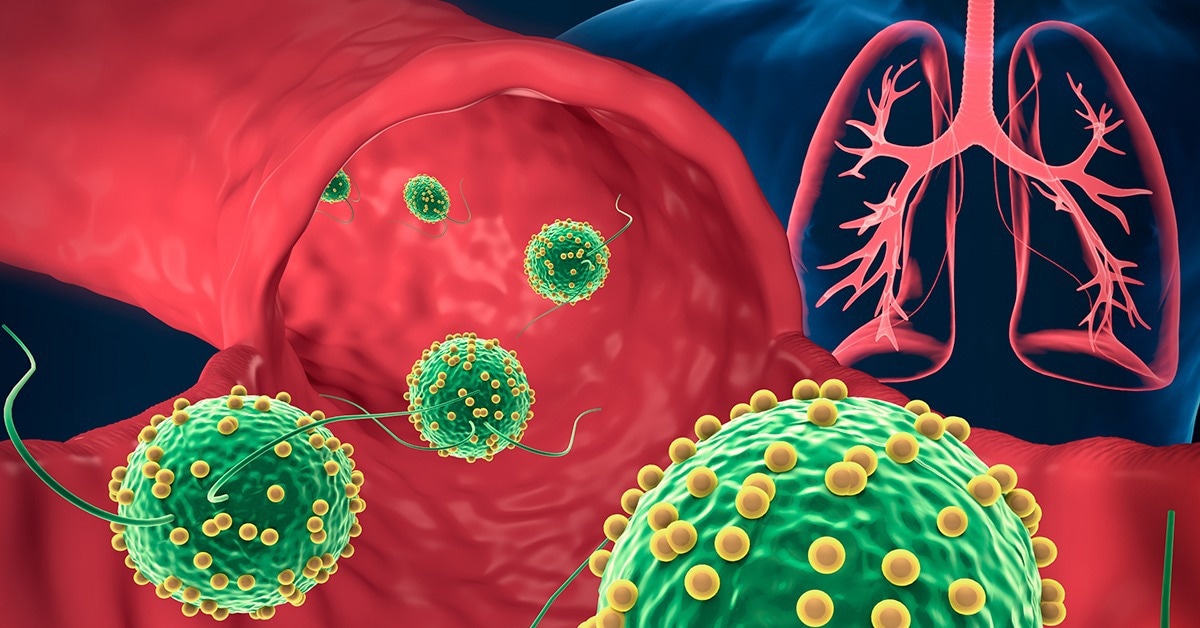
Illustration of microrobots entering the lungs to treat pneumonia. Image Credit: Wang lab/UC San Diego
The unique microrobots effectively removed pneumonia-triggering bacteria from the lungs of mice with a 100% survival outcome. In comparison, all the mice that were not treated died within three days after contracting the infection.
The results have been reported in the September 22nd issue of the journal Nature Materials.
The microrobots are composed of algae cells whose surfaces are spotted with antibiotic-filled nanoparticles. The algae offer movement, which enables the microrobots to swim about and supply antibiotics straightaway to more bacteria in the lungs. The nanoparticles comprising the antibiotics are composed of minute eco-friendly polymer spheres coated with the cell membranes of neutrophils, a form of white blood cells.
The unique factor concerning these cell membranes is that they capture and defuse inflammatory molecules formed by bacteria and the body's immune system. This provides the microrobots the capacity to minimize detrimental inflammation, which in turn renders them more effective at combating lung infection.
The work is a collaborative effort between the labs of nanoengineering professors Liangfang Zhang and Joseph Wang, both at the Jacobs School of Engineering (UC San Diego). Wang is a renowned expert in the domain of micro- and nanorobotics research, while Zhang is a renowned expert in creating cell-imitating nanoparticles for treating diseases and infections.
Wang and Zhang have pioneered the advancement of miniature drug-delivering robots that can be safely applied to live animals to treat bacterial contagions in the blood and the stomach. Their latest line of work is treating bacterial lung infections.
Our goal is to do targeted drug delivery into more challenging parts of the body, like the lungs. And we want to do it in a way that is safe, easy, biocompatible, and long-lasting. That is what we’ve demonstrated in this work.
Liangfang Zhang, Professor, Jacobs School of Engineering, University of California San Diego
The researchers used microrobots to treat mice with an acute and possibly terminal form of pneumonia caused by the bacteria Pseudomonas aeruginosa. This type of pneumonia usually affects patients administered mechanical ventilation in the intensive care unit.
The scientists directed the microrobots to the lungs of the mice via a tube inserted in the windpipe. The infections completely resolved after a week. All the mice treated with the microrobots lived over 30 days, while mice that did not receive treatment died within three days.
Furthermore, treatment using the microrobots was more fruitful than an IV antibiotics injection into the bloodstream. The latter needed a dose of antibiotics that was 3000 times higher than that used in the microrobots to attain the same result. For better understanding, a dose of microrobots delivered 500 nanograms of antibiotics per mouse, while an IV injection delivered 1.644 mg of antibiotics per mouse.
The team’s method is very effective as it places the medication directly where it has to go instead of diffusing it via the rest of the body.
“These results show how targeted drug delivery combined with active movement from the microalgae improves therapeutic efficacy,” said Wang.
With an IV injection, sometimes only a very small fraction of antibiotics will get into the lungs. That’s why many current antibiotic treatments for pneumonia don’t work as well as needed, leading to very high mortality rates in the sickest patients. Based on these mouse data, we see that the microrobots could potentially improve antibiotic penetration to kill bacterial pathogens and save more patients’ lives.
Victor Nizet, Professor and Study Co-Author, School of Medicine and Skaggs School of Pharmacy and Pharmaceutical Sciences, University of California San Diego
Victor Nizet is also a physician-scientist collaborator of Wang and Zhang.
In case the idea of depositing algae cells in one’s lungs makes one queasy, the scientists state that this method is safe. After treatment, the immune cells of the body efficiently digest the algae, together with any residual nanoparticles.
Nothing toxic is left behind.
Joseph Wang, Professor, Jacobs School of Engineering, UC San Diego
The study is only in the proof-of-concept phase. The researchers hope to perform more standard research to comprehend precisely how the microrobots interact with the immune system. The subsequent steps also include studies to confirm the microrobot treatment and expanding it before testing reaches humans.
We’re pushing the boundary further in the field of targeted drug delivery.
Liangfang Zhang, Professor, Jacobs School of Engineering, University of California San Diego
The National Institutes of Health (R01CA200574) supported this study.
Journal Reference:
Zhang, F., et al. (2022) Nanoparticle-modified microrobots for in vivo antibiotic delivery to treat acute bacterial pneumonia. Nature Materials. doi.org/10.1038/s41563-022-01360-9.